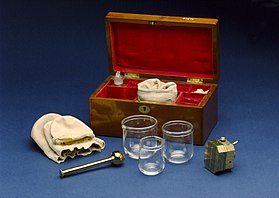
Back حجامة صينية Arabic কাপিং থেরাপি Bengali/Bangla Ventosateràpia Catalan Baňkování Czech Kopsætning Danish Schröpfen German Βεντούζα Greek Kupado Esperanto Ventosaterapia Spanish Kupupanemine Estonian
| Cupping therapy | |
|---|---|
 Cupping and bloodletting set, from London, dating from 1860–1875 | |
| Alternative therapy |
| This article is part of a series on |
| Alternative medicine |
|---|
 |
| Cupping therapy | |||||||||||||||||||||||||||||||
|---|---|---|---|---|---|---|---|---|---|---|---|---|---|---|---|---|---|---|---|---|---|---|---|---|---|---|---|---|---|---|---|
| Chinese name | |||||||||||||||||||||||||||||||
| Traditional Chinese | 拔罐 | ||||||||||||||||||||||||||||||
| Simplified Chinese | 拔罐 | ||||||||||||||||||||||||||||||
| |||||||||||||||||||||||||||||||
| Vietnamese name | |||||||||||||||||||||||||||||||
| Vietnamese alphabet | Giác hơi | ||||||||||||||||||||||||||||||
| Chữ Hán | 覺有 | ||||||||||||||||||||||||||||||
| Korean name | |||||||||||||||||||||||||||||||
| Hangul | 부항 | ||||||||||||||||||||||||||||||
| Hanja | 附缸 | ||||||||||||||||||||||||||||||
| |||||||||||||||||||||||||||||||
Cupping therapy is a form of pseudoscience in which a local suction is created on the skin with the application of heated cups. As alternative medicine it is practiced primarily in Asia but also in Eastern Europe, the Middle East, and Latin America.[1][2] The practice of cupping has been characterized as quackery.[3][4]
Cupping practitioners attempt to use cupping therapy for a wide array of medical conditions including fevers, chronic low back pain, poor appetite, indigestion, high blood pressure, acne, atopic dermatitis, psoriasis, anemia, stroke rehabilitation, nasal congestion, infertility, and menstrual period cramping.[1][2]
Despite the numerous ailments for which practitioners claim cupping therapy is useful, there is insufficient evidence demonstrating it has any health benefits, and there are some risks of harm, especially from wet cupping and fire cupping.[1] Bruising and skin discoloration are among the adverse effects of cupping and are sometimes mistaken for child abuse.[2] In rare instances, the presence of these marks on children has led to legal action against parents who had their children receive cupping therapy.[2]
- ^ a b c Cite error: The named reference
Vashi2018was invoked but never defined (see the help page). - ^ a b c d Lilly, E; Kundu, RV (April 2012). "Dermatoses secondary to Asian cultural practices". International Journal of Dermatology. 51 (4): 372–379. doi:10.1111/j.1365-4632.2011.05170.x. PMID 22435423. S2CID 32407869.
- ^ Crislip, Mark (24 December 2014). "Acupuncture Odds and Ends". Science-Based Medicine. Retrieved 8 August 2016.
- ^ Cite error: The named reference
quackwas invoked but never defined (see the help page).